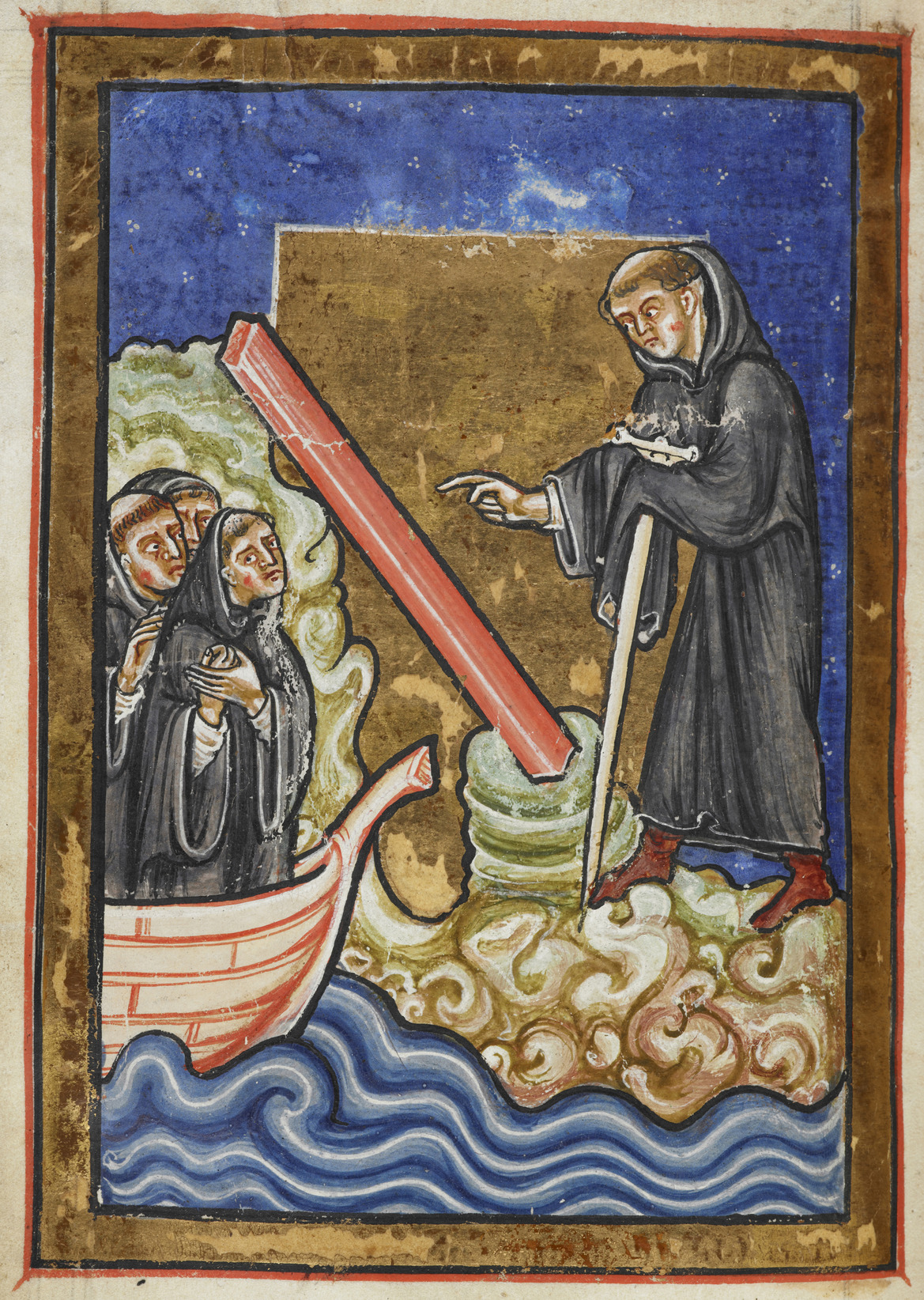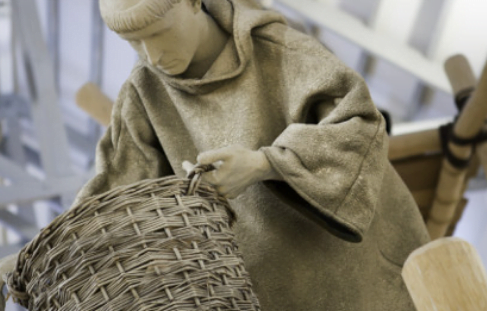gollygolly
Active Member
- Time of past OR future Camino
- 2000/13/14/15/16/17/18/19/2021/22/23
St Cuthbert's Way - a walk through commencing in Melrose in the Borders, Scotland, and finishing on the Holy Island of Lindisfarne, Northumberland.
This is not that long a walk, and at 62.5 miles / 100.5kms long would only just qualify for receiving a Compostela were this walk to have ended in Santiago de Compostela. Apparently the majority of walkers will complete this route with 5 days of walking, and that is also the case for us, though these 5 days include a break-day along the way, as will be explained, so a total of 4 days of actual waking.
Based on my own personal criteria for evaluating the difficulty or ease of a walk, I would judge this as being of modest difficulty, with only 2 sections that required a degree of exertion. The weather was generally kind, frequently Goldilocks weather, which is not too hot and not too cold. Yes, it rained, though as something of a Scottish saying goes, if you don't like the rain, wait another 15 minutes, as the rain will stop and the weather will change. The only inconvenience of the rain was the frequent donning and taking of the protective rain poncho. While we had been warned of a problem with midges, we never encountered any, so for us there was no problem at all. Accommodation and food. This is not comparable with walking along the Camino Frances towards Santiago, where albergues and pensiones will be readily found, generally at a very, very accessible budget. If walking along St Cuthbert's Way, most of the accommodation available will be found in hotels or bed & breakfasts, and none that we stayed at offered 'pilgrim/peregrino' rates, nor do the bars/cafes/restaurants along the way offer an equivalent of the menu de dia or menu del peregrino.
For us, the planning for this walk was very much dictated by the dates for our stay . At the initial planning stage, there was no accommodation available on Holy Island. When a cancellation allowed a self-catering cottage to become available, I quickly responded and reserved those 2 nights that were offered, and began the planning of the walk.
And so to the actual walk.
We flew to Edinburgh, stayed there a day and then took the train to Tweedbank, which is almost adjacent to Melrose. Melrose is the official commencement point for the walk, as well as the location of Melrose Abbey, a Cistercian monastery from the 12th century that today lies in ruins. The day prior to commencing the walk, we headed to see the Abbey, as well as collect a stamp for our pilgrim passport/credencial. We used a couple of passports/credenciales obtained from the Confraternity of St James, details further down. Within the grounds of Melrose Abbey there is a plaque indicating the alleged location of the heart of Robert the Bruce. After staying in Melrose overnight, we left early on the following morning.
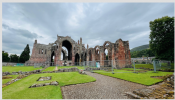 Melrose Abbey
Melrose Abbey
Day 1 of St Cuthbert's Way
Melrose to Jedburgh
The first few hundred metres are on an asphalt road, before abruptly heading on to an uphill stepped path, which is quite demanding. I rate this section as one of the two demanding uphill sections along the St Cuthbert's Way. A very rapid change of walking tempo, though with the ascent there were some great views back across Melrose, as well as of the very beautiful surrounding countryside, with on the day of our walking, the possibility of seeing for many kilometres. There is a conveniently located bench in tribute to John Henderson, who had been a strong force in reviving St Cuthbert's Way - a link to his obituary can be found further down. The bench, as well as offering a place to pause and recuperate after the climb, is a work of art in its own right, as can be seen in the images. The route marking is not too bad, though that did not prevent us from being distracted by the views and going adrift as we began descending. We were fortunate to coincide with a couple who were out walking their dogs, and were soon directed by the dog walkers back on the correct route. We made a slight deviation so as to visit another Abbey that is in ruins, the remains of the 12th century Dryburgh Abbey. This Abbey is very scenically located, almost on the banks of the River Tweed, a very recognised river for fly fishing of salmon. The grounds of the Abbey, with some magnificent trees, also has the location of the graves for Sir Walter Scott and Field Marshal Douglas Haig, 1st Earl Haig, who famously led the British army in the First World War and along with his wife, founded the poppy appeal with the infamous making of poppies to raise funds for armed forces veterans requiring support.
The walk continues along the very beautiful River Tweed, with an occasional angler to be spotted while walking alongside the river. Our ideal would have been to have ended the first day of walking at Harestanes, though there is a paucity of accommodation there, and so we headed to Jedburgh, and our overnight there, slightly removed from the actual St Cuthbert's Way. The charms of the town somehow eluded us, and while there are the very impressive ruins of Jedburgh Abbey, this one being another abbey from the 12th Century, though an Augustinian abbey. The setting does not have the magnificence as that of Dryburgh Abbey or Melrose Abbey, and while the scale of Jedburgh Abbey is impactful, it feels encroached by the surrounding buildings. The town is also the location of Mary Queen of Scots House, where she briefly resided and also the birthplace of James Thomson, who wrote the words to 'Rule Britannia'.
 initial stepped path climb out of Melrose
initial stepped path climb out of Melrose
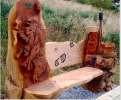
The dedicated bench as a tribute to John Henderson - note the outline of Scotland on the left hand side
 detail : note the boots and the laces
detail : note the boots and the laces

Dryburgh Abbey - note both Sir Walter Scott's and Field Marshal Douglas Haig's graves
Day 2 of St Cuthbert's Way
Jedburgh to Kirk Yetholm
We planned to walk directly from Jedburgh, passing the remains of Cessford Castle, so as to return to the St Cuthbert's Way. Having passed by Jedburgh Abbey and collected the stamp for the passport/credencial, we made the gentle climb out of the town and along the very quiet road that led to Crailinghall, a settlement of a few houses and farms, and a solitary red BT phone box. A calculation, or rather a miscalculation, that we could leave the asphalt road and go cross-country to Cessford Castle, had us making a wonderful circuitous walk. All very beautiful, including seeing young roe deer, though we found that we were back on the road in Crailinghall, and with the need to press on. So, keeping to the asphalt road and with very, very infrequent traffic, we continued. Not long after passing the remains of Cessford Castle, we rejoined St Cuthbert's Way, and then stopped for a late lunch in Morebattle. Leaving Morebattle behind, we then had the second reasonably strong climb of the walk, ascending to the top of Wideopen Hill. The small mercy was that the wind was in our favour as we climbed. At the top of the climb is the half-way point between Melrose and Holy Island, as well as the highest point of the walk. The views from there were, on this quite clear day, incredible. From the natural vantage point, we gently descended to the destination for the day, Kirk Yetholm.
In contrast to Harestanes, the town of Kirk Yetholm has quite a few places to choose as to where to stay. We stayed in the hostel, Friends of Nature House, and were very, very pleased with the choice. Kirk Yetholm is the end of, or perhaps for some, the beginning, of the Pennine Way, and there is/was an impressive collection of walking poles and footwear that had been left behind outside at one of the hotels, left by some of those who had completed the Pennine Way.
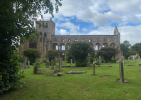
Jedburgh Abbey
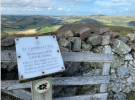
Highest point of St Cuthbert's Way, as well as the half-way point

Kirk Yetholm - where St Cuthbert's Way and the Pennine Way meet
Day 3 of St Cuthbert's Way
Kirk Yetholm to Wooler
Leaving Kirk Yetholm in slight drizzle, made a short diversion to the local church, The Kirk of Yetholm, and added the imprint from their rubber stamp to our passport/credenciales. With the drizzle turning to rain, time to don the rain poncho and continue onwards and upwards, with the rain quickly passing and sunshine once again emerging. This day presented a beautiful section of walking, with quite varied nature, including pasture with cattle and lowland with grazing sheep as well as large open moor space with gorse and heather and where grouse shooting is conducted, with the carefully constructed hides for the guns.
Descending gently from the expanse of the grouse moors, the route enters Wooler. Somewhere along the trodden path, Scotland had been left behind and England had been entered, though was at a loss to recall passing on the path any indication of this geopolitical frontier. What I was aware of was that the walk today had been exceptionally beautiful, and the nature quite varied, including having the good fortune to see the wild goats, plenty of flocks as well as solitary sheep, and enough species of birds to keep an ornithologist happy. Wooler offered a variety of accommodation, and we were staying this night in a shepherd's hut, the choice seeming an apt one, given the number of sheep that had been encountering and had been passing
on the walk.
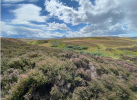
Part of the expanse of the open moor land
Day 4 - no walking
Side trip to Alnwick Castle
An absolute first for us, breaking the walk with this strongly recommended diversion and day off from St Cuthbert's Way. For those who are unfamiliar with Alnwick and Alnwick Castle, the castle was used as the location for some scenes in two of the Harry Potter films, as well as a location in one of the Downton Abbey films. We returned to Wooler for the overnight stay there.
Day 5 of St Cuthbert's Way
Wooler to Holy Island
This was the final day, and because the intended final part of the walk, crossing the sand causeway to Holy Island, required that we arrive and cross before the tide water came back in, we had to start early. Accordingly, shortly before 5am we had departed and with a steady pace ascended from Wooler and back to moor country, frequently startling grouse that rose from almost under our feet with their call of alarm ringing across the countryside. We briefly paused at the wood carving of St Cuthbert, where a close by wood bench provided momentary rest, before it was onwards. We stopped at what is known as St Cuthbert's Cave, today in the protective ownership of the National Trust, and where it is alleged St Cuthbert at one time sheltered or possibly lived for a period of time. From the cave, there was a gentle descent towards Fenwick, a small settlement where we had an exceptionally good coffee and snack break. Geoffrey Chaucer wrote the Canterbury Tales, is given credit for the quotation that 'Time and tide waits for no man', and conscious of the time and the time of the incoming tide, it was necessary for us to continue. The sea and the distant silhouette of Holy Island and the distinct outline of Lindisfarne Castle were coming into sharper focus as we continued in the direction of the shore. The beach edge has as evidence of the measures taken during the 1939-45 war to prevent Nazi German invasion, a long line of large concrete blocks to assist in preventing landing craft beaching. A preventative measure that was fortunately never required. We were now at sea level, and slightly tight for time. A personal decision was made to walk the sand causeway, though with the waking boots still on. The impressions on the sand revealed that some walkers had passed already, some who had clearly chosen to walk barefoot. And so began the final part of the walk, across the sand causeway to the island. This is very well indicated, though keeping faithfully to walking via the poles is not that straightforward. My calculation is that it was close to 90 minutes of walking to get across the causeway, and that this is not an undertaking to do other than with certainty of the tides. More or less at about 1pm stepped off the sand onto the Holy Island of Lindisfarne, completing the 100 and a bit kilometres along the way from the starting place, Melrose.
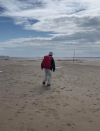
crossing the sand causeway - note the other foot prints from earlier in the day
A strongly recommended short walk, and strongly recommend staying on the island, which is exceptionally special. Something extraordinary as the influx of visitors who came over with the receding tide, are hours later departing as the time for the incoming tide approaches. With the visitors departing, the peace and tranquility to be experienced on the island are an absolute blessing.
Highlights :
• The Holy Island of Lindisfarne
• Scottish Borders countryside
• Three Great Border Abbeys (Melrose Abbey, Dryburgh Abbey and Jedburgh Abbey in Scotland
• Eildon Hills, Cheviot Hills and the moors
• Wideopen Hill
• Northumberland National Park, England
• St Cuthbert’s Cave
• Cessford Castle
• while we only saw a little part, the Northumberland Coast, England
Links :
On the actual walk : https://www.stcuthbertsway.info
Pilgrim passports/credenciales : Confraternity of St James UK / https://www.csj.org.uk / email : office@csj.org.uk
Obituary to John Henderson : https://www.scotsman.com/news/peopl...scottish-long-distance-walking-routes-3145790
Alnwick Castle : https://www.alnwickcastle.com/
On The Holy Island of Lindisfarne : https://visitlindisfarne.com/
For safe times to cross, refer to the tides : https://holyislandcrossingtimes.northumberland.gov.uk/
This is not that long a walk, and at 62.5 miles / 100.5kms long would only just qualify for receiving a Compostela were this walk to have ended in Santiago de Compostela. Apparently the majority of walkers will complete this route with 5 days of walking, and that is also the case for us, though these 5 days include a break-day along the way, as will be explained, so a total of 4 days of actual waking.
Based on my own personal criteria for evaluating the difficulty or ease of a walk, I would judge this as being of modest difficulty, with only 2 sections that required a degree of exertion. The weather was generally kind, frequently Goldilocks weather, which is not too hot and not too cold. Yes, it rained, though as something of a Scottish saying goes, if you don't like the rain, wait another 15 minutes, as the rain will stop and the weather will change. The only inconvenience of the rain was the frequent donning and taking of the protective rain poncho. While we had been warned of a problem with midges, we never encountered any, so for us there was no problem at all. Accommodation and food. This is not comparable with walking along the Camino Frances towards Santiago, where albergues and pensiones will be readily found, generally at a very, very accessible budget. If walking along St Cuthbert's Way, most of the accommodation available will be found in hotels or bed & breakfasts, and none that we stayed at offered 'pilgrim/peregrino' rates, nor do the bars/cafes/restaurants along the way offer an equivalent of the menu de dia or menu del peregrino.
For us, the planning for this walk was very much dictated by the dates for our stay . At the initial planning stage, there was no accommodation available on Holy Island. When a cancellation allowed a self-catering cottage to become available, I quickly responded and reserved those 2 nights that were offered, and began the planning of the walk.
And so to the actual walk.
We flew to Edinburgh, stayed there a day and then took the train to Tweedbank, which is almost adjacent to Melrose. Melrose is the official commencement point for the walk, as well as the location of Melrose Abbey, a Cistercian monastery from the 12th century that today lies in ruins. The day prior to commencing the walk, we headed to see the Abbey, as well as collect a stamp for our pilgrim passport/credencial. We used a couple of passports/credenciales obtained from the Confraternity of St James, details further down. Within the grounds of Melrose Abbey there is a plaque indicating the alleged location of the heart of Robert the Bruce. After staying in Melrose overnight, we left early on the following morning.
 Melrose Abbey
Melrose Abbey Day 1 of St Cuthbert's Way
Melrose to Jedburgh
The first few hundred metres are on an asphalt road, before abruptly heading on to an uphill stepped path, which is quite demanding. I rate this section as one of the two demanding uphill sections along the St Cuthbert's Way. A very rapid change of walking tempo, though with the ascent there were some great views back across Melrose, as well as of the very beautiful surrounding countryside, with on the day of our walking, the possibility of seeing for many kilometres. There is a conveniently located bench in tribute to John Henderson, who had been a strong force in reviving St Cuthbert's Way - a link to his obituary can be found further down. The bench, as well as offering a place to pause and recuperate after the climb, is a work of art in its own right, as can be seen in the images. The route marking is not too bad, though that did not prevent us from being distracted by the views and going adrift as we began descending. We were fortunate to coincide with a couple who were out walking their dogs, and were soon directed by the dog walkers back on the correct route. We made a slight deviation so as to visit another Abbey that is in ruins, the remains of the 12th century Dryburgh Abbey. This Abbey is very scenically located, almost on the banks of the River Tweed, a very recognised river for fly fishing of salmon. The grounds of the Abbey, with some magnificent trees, also has the location of the graves for Sir Walter Scott and Field Marshal Douglas Haig, 1st Earl Haig, who famously led the British army in the First World War and along with his wife, founded the poppy appeal with the infamous making of poppies to raise funds for armed forces veterans requiring support.
The walk continues along the very beautiful River Tweed, with an occasional angler to be spotted while walking alongside the river. Our ideal would have been to have ended the first day of walking at Harestanes, though there is a paucity of accommodation there, and so we headed to Jedburgh, and our overnight there, slightly removed from the actual St Cuthbert's Way. The charms of the town somehow eluded us, and while there are the very impressive ruins of Jedburgh Abbey, this one being another abbey from the 12th Century, though an Augustinian abbey. The setting does not have the magnificence as that of Dryburgh Abbey or Melrose Abbey, and while the scale of Jedburgh Abbey is impactful, it feels encroached by the surrounding buildings. The town is also the location of Mary Queen of Scots House, where she briefly resided and also the birthplace of James Thomson, who wrote the words to 'Rule Britannia'.
 initial stepped path climb out of Melrose
initial stepped path climb out of Melrose
The dedicated bench as a tribute to John Henderson - note the outline of Scotland on the left hand side
 detail : note the boots and the laces
detail : note the boots and the laces
Dryburgh Abbey - note both Sir Walter Scott's and Field Marshal Douglas Haig's graves
Day 2 of St Cuthbert's Way
Jedburgh to Kirk Yetholm
We planned to walk directly from Jedburgh, passing the remains of Cessford Castle, so as to return to the St Cuthbert's Way. Having passed by Jedburgh Abbey and collected the stamp for the passport/credencial, we made the gentle climb out of the town and along the very quiet road that led to Crailinghall, a settlement of a few houses and farms, and a solitary red BT phone box. A calculation, or rather a miscalculation, that we could leave the asphalt road and go cross-country to Cessford Castle, had us making a wonderful circuitous walk. All very beautiful, including seeing young roe deer, though we found that we were back on the road in Crailinghall, and with the need to press on. So, keeping to the asphalt road and with very, very infrequent traffic, we continued. Not long after passing the remains of Cessford Castle, we rejoined St Cuthbert's Way, and then stopped for a late lunch in Morebattle. Leaving Morebattle behind, we then had the second reasonably strong climb of the walk, ascending to the top of Wideopen Hill. The small mercy was that the wind was in our favour as we climbed. At the top of the climb is the half-way point between Melrose and Holy Island, as well as the highest point of the walk. The views from there were, on this quite clear day, incredible. From the natural vantage point, we gently descended to the destination for the day, Kirk Yetholm.
In contrast to Harestanes, the town of Kirk Yetholm has quite a few places to choose as to where to stay. We stayed in the hostel, Friends of Nature House, and were very, very pleased with the choice. Kirk Yetholm is the end of, or perhaps for some, the beginning, of the Pennine Way, and there is/was an impressive collection of walking poles and footwear that had been left behind outside at one of the hotels, left by some of those who had completed the Pennine Way.

Jedburgh Abbey

Highest point of St Cuthbert's Way, as well as the half-way point

Kirk Yetholm - where St Cuthbert's Way and the Pennine Way meet
Day 3 of St Cuthbert's Way
Kirk Yetholm to Wooler
Leaving Kirk Yetholm in slight drizzle, made a short diversion to the local church, The Kirk of Yetholm, and added the imprint from their rubber stamp to our passport/credenciales. With the drizzle turning to rain, time to don the rain poncho and continue onwards and upwards, with the rain quickly passing and sunshine once again emerging. This day presented a beautiful section of walking, with quite varied nature, including pasture with cattle and lowland with grazing sheep as well as large open moor space with gorse and heather and where grouse shooting is conducted, with the carefully constructed hides for the guns.
Descending gently from the expanse of the grouse moors, the route enters Wooler. Somewhere along the trodden path, Scotland had been left behind and England had been entered, though was at a loss to recall passing on the path any indication of this geopolitical frontier. What I was aware of was that the walk today had been exceptionally beautiful, and the nature quite varied, including having the good fortune to see the wild goats, plenty of flocks as well as solitary sheep, and enough species of birds to keep an ornithologist happy. Wooler offered a variety of accommodation, and we were staying this night in a shepherd's hut, the choice seeming an apt one, given the number of sheep that had been encountering and had been passing
on the walk.

Part of the expanse of the open moor land
Day 4 - no walking
Side trip to Alnwick Castle
An absolute first for us, breaking the walk with this strongly recommended diversion and day off from St Cuthbert's Way. For those who are unfamiliar with Alnwick and Alnwick Castle, the castle was used as the location for some scenes in two of the Harry Potter films, as well as a location in one of the Downton Abbey films. We returned to Wooler for the overnight stay there.
Day 5 of St Cuthbert's Way
Wooler to Holy Island
This was the final day, and because the intended final part of the walk, crossing the sand causeway to Holy Island, required that we arrive and cross before the tide water came back in, we had to start early. Accordingly, shortly before 5am we had departed and with a steady pace ascended from Wooler and back to moor country, frequently startling grouse that rose from almost under our feet with their call of alarm ringing across the countryside. We briefly paused at the wood carving of St Cuthbert, where a close by wood bench provided momentary rest, before it was onwards. We stopped at what is known as St Cuthbert's Cave, today in the protective ownership of the National Trust, and where it is alleged St Cuthbert at one time sheltered or possibly lived for a period of time. From the cave, there was a gentle descent towards Fenwick, a small settlement where we had an exceptionally good coffee and snack break. Geoffrey Chaucer wrote the Canterbury Tales, is given credit for the quotation that 'Time and tide waits for no man', and conscious of the time and the time of the incoming tide, it was necessary for us to continue. The sea and the distant silhouette of Holy Island and the distinct outline of Lindisfarne Castle were coming into sharper focus as we continued in the direction of the shore. The beach edge has as evidence of the measures taken during the 1939-45 war to prevent Nazi German invasion, a long line of large concrete blocks to assist in preventing landing craft beaching. A preventative measure that was fortunately never required. We were now at sea level, and slightly tight for time. A personal decision was made to walk the sand causeway, though with the waking boots still on. The impressions on the sand revealed that some walkers had passed already, some who had clearly chosen to walk barefoot. And so began the final part of the walk, across the sand causeway to the island. This is very well indicated, though keeping faithfully to walking via the poles is not that straightforward. My calculation is that it was close to 90 minutes of walking to get across the causeway, and that this is not an undertaking to do other than with certainty of the tides. More or less at about 1pm stepped off the sand onto the Holy Island of Lindisfarne, completing the 100 and a bit kilometres along the way from the starting place, Melrose.

crossing the sand causeway - note the other foot prints from earlier in the day
A strongly recommended short walk, and strongly recommend staying on the island, which is exceptionally special. Something extraordinary as the influx of visitors who came over with the receding tide, are hours later departing as the time for the incoming tide approaches. With the visitors departing, the peace and tranquility to be experienced on the island are an absolute blessing.
Highlights :
• The Holy Island of Lindisfarne
• Scottish Borders countryside
• Three Great Border Abbeys (Melrose Abbey, Dryburgh Abbey and Jedburgh Abbey in Scotland
• Eildon Hills, Cheviot Hills and the moors
• Wideopen Hill
• Northumberland National Park, England
• St Cuthbert’s Cave
• Cessford Castle
• while we only saw a little part, the Northumberland Coast, England
Links :
On the actual walk : https://www.stcuthbertsway.info
Pilgrim passports/credenciales : Confraternity of St James UK / https://www.csj.org.uk / email : office@csj.org.uk
Obituary to John Henderson : https://www.scotsman.com/news/peopl...scottish-long-distance-walking-routes-3145790
Alnwick Castle : https://www.alnwickcastle.com/
On The Holy Island of Lindisfarne : https://visitlindisfarne.com/
For safe times to cross, refer to the tides : https://holyislandcrossingtimes.northumberland.gov.uk/
Last edited:





